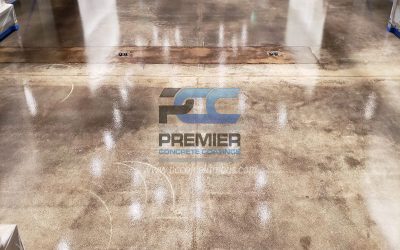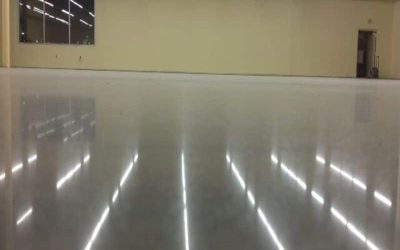More and more property owners choose cement polishing to upgrade and rejuvenate their plain-looking concrete surfaces. Professionally polished concrete has several benefits, but does it weaken the surface?
The short answer is it depends on the quality of installation and moisture levels in the concrete. It’s crucial to note that cement polishing requires the professional expertise of an experienced contractor. Improper polishing ultimately damages a concrete surface.
Let’s discuss the impact of polishing your concrete and why doing it right matters.
The Cement Polishing Process
Understanding moisture’s role in concrete and how it affects the quality of an installation comes in handy. The moisture content in concrete begins as the water that is part of the concrete mix necessary for the concrete hydration process.
Too much water results in longer concrete drying times and a structurally weaker surface. Too little moisture results in flaking, cracks, and difficulty troweling it to the right finish.
Polishing a concrete floor generally consists of burnishing and polishing. Burnishing aims to give the floor surface a smooth, durable surface by removing trowel marks, pits, stains, or even previous coatings from the slab surface.
Burnishing typically involves grinding the surface with a hard abrasive such as diamond grit to eliminate surface imperfections. Unfortunately, burnishing can grind the surface and leave the capillaries that allow moisture to escape the slab open. However, that has the opposite effect.
As the hard abrasive grinds dust and residue into the surface, the process can plug those openings into the concrete surface.
As the final stage of the flooring finish, cement polishing also carries the risk of sealing the slab’s pores. Often, contractors apply a polishing sealer at the final stage that the slab absorbs, acting as a substitute for a coating.
Both burnishing and polishing increase the possibility that excess moisture will get trapped under the sealed surface. Over time, that moisture will result in cracks, scaling, discolorations, or finish failures.
Effects of Excessive Moisture on Concrete Floors
Water is an essential component when making concrete. The moisture from water also gives concrete its strength during the curing process. While water is one of the crucial components of a concrete mix, excessive water does more harm than good to the concrete’s structural integrity.
Increased Space Between Cement Grains
Excess water in a concrete mix increases the spacing between aggregates in cement, which affects compaction. Similarly, higher moisture levels reduce the concrete’s compressive durability and strength.
When excess water increases the spaces between aggregate materials, the voids fill with air once the moisture evaporates. The resulting inadequate compaction compromises the concrete’s strength.
pH Levels
Relative humidity levels and pH in concrete have a directly proportional relationship. Higher humidity levels increase the concrete’s pH and temperature, and as pH increases, so does the likelihood of the floor covering adhesive bonds failing.
While concrete dries faster in higher temperatures, it results in a less structured, more porous concrete surface.
Cracking and Dusting
Concrete that dries too quickly or sealants mixed with too much water can cause unintentional cracks in the surface. Excess water at the surface may also weaken the concrete and cause dusting when dry.
Mold
Wet conditions create a perfect breeding ground for bacteria and mold. This may erode concrete and damage the floor’s integrity. Mold will stain and make concrete lose its aesthetic appeal if not thoroughly cleaned.
Discoloration Cement Polishing
Excess moisture can discolor stained concrete. Moisture may cause a selected color to appear darker or lighter than its original hue.
Efflorescence Cement Polishing
When a concrete surface contains too much moisture, it may lead to crystalline deposits on the surface of the concrete. This salty residue appears as a whitish film on decorative concrete and ruins the floor’s overall look.
Testing the humidity levels of the concrete plays a crucial role in avoiding excessive moisture. Reliable relative humidity (RH) testing performed before executing the finishing process best protects that shiny finished floor.
Determining the internal moisture levels of a concrete slab allows flooring contractors to accurately predict the success or failure of a flooring material or finish.
Get a Free Cement Polishing Quote
Although DIY projects keep gaining popularity by the day, when it comes to cement polishing, you want to hire a professional. Polishing concrete floors takes training, practice, and plenty of experience.
Hiring experts saves time and money while guaranteeing the best results.
For more information on cement polishing and other decorative concrete services, contact Premier Coatings of Columbus. Call us at (614) 918-7345 to discuss your needs and request a free quote.



